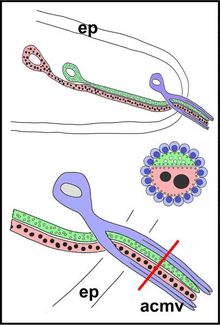Rhabditophora
Rhabditophora (from rhabdito-, rhabdite + Greek -φορος [-phoros], bearer, i.e., "rhabdite bearers") is a class of flatworms. It includes all parasitic flatworms (clade Neodermata) and most free-living species that were previously grouped in the now obsolete class Turbellaria. Therefore, it contains the majority of species in the phylum Platyhelminthes, excluding only the catenulids, to which they appear to be the sister group.
| Rhabditophora | |
|---|---|
| Macrostomum lignano, a rhabditophoran | |
| Scientific classification | |
| Kingdom: | Animalia |
| Clade: | Bilateria |
| Clade: | Nephrozoa |
| (unranked): | Protostomia |
| (unranked): | Spiralia |
| Clade: | Rouphozoa |
| Phylum: | Platyhelminthes |
| Class: | Rhabditophora Ehlers, 1985 |
| Subgroups | |
The clade Rhabditophora was originally erected by Ulrich Ehlers in 1985[1] based on morphological analyses and its monophyly was later confirmed by molecular studies.[2]
Description
Rhabditophorans are characterized by the presence of lamellated rhabdites, rodlike granules secreted in the cells of the epidermis and consisted of concentric lamellae. They are absent in the clade Neodermata, most likely due to a secondary loss of this feature because their epidermis is turned into a syncytium in adult forms.[1]

Another important synapomorphy of the group is the duo-glandular adhesive system. It is a structure of the epidermis containing three different cell types: anchor cells, adhesive glands and releasing glands. The adhesive glands secrete an adhesive substance that attaches the anchor cells to a surface, while the releasing glands secrete a substance able to release the anchor cells from surfaces.[1] This systems allows rhabditophorans to adhere and release quickly from the substrate, even several times in a second.[3]
The secretory organs of rhabditophorans, the protonephridia, also have a unique anatomy in which the flame cells and tube cells present a series of cytoplasmic projections that overlap, forming a two-cell 'weir'.[1]
Systematics
Current classification of Rhabditophora based on several morphological and molecular studies:[4][5]
- Subclass Macrostomorpha
- Order Macrostomida
- Order Haplopharyngida
- Subclass Trepaxonemata
- Clade Amplimatricata
- Order Lecithoepitheliata
- Order Polycladida
- Clade Euneoophora
- Order Rhabdocoela
- Order Proseriata
- Clade Acentrosomata
- Clade Adiaphanida
- Order Prolecithophora
- Order Fecampiida
- Order Tricladida
- Clade Bothrioneodermata
- Order Bothrioplanida
- Clade Neodermata (parasites)
- Clade Adiaphanida
- Clade Amplimatricata
References
- Ehlers, U. (1985) Phylogenetic relationships within the Platyhelminthes. In S. Conway Morris; J. D. George; R. Gibson; H. M. Platt (Eds.), The origins and relationships of lower invertebrates. Oxford, Clarendon Press, p. 143-158.
- Larsson, K; Jondelius, U (2008). "Phylogeny of the Catenulida and support for Platyhelminthes". Organisms Diversity & Evolution. 8 (5): 378–387. doi:10.1016/j.ode.2008.09.002.
- Lengerer, B; Pjeta, R.; Wunderer, J.; Rodrigues, M.; Arbore, R.; Schärer, L.; Berezikov, E.; Hess, M. W..; Pfaller, K.; Egger, B.; Obwegeser, S.; Salvenmoser, W.; Ladurner, P. (2014). "Biological adhesion of the flatworm Macrostomum lignano relies on a duo-gland system and is mediated by a cell type-specific intermediate filament protein". Frontiers in Zoology. 11 (1): 12. doi:10.1186/1742-9994-11-12. PMC 4016567. PMID 24520881.
- Egger, B; Lapraz, F.; Tomiczek, B.; Müller, S.; Dessimoz, C.; Girstmair, J.; Škunca, N.; Rawlinson, K. A.; Cameron, C. B.; Beli, E.; Todaro, M. A.; Gammoudi, M.; Norẽna, C.; Telford, M. (2015). "A transcriptomic-phylogenomic analysis of the evolutionary relationships of flatworms". Current Biology. 25 (10): 1347–1353. doi:10.1016/j.cub.2015.03.034. PMC 4446793. PMID 25866392.
- Norén, M; Jondelius, U (1999). "Phylogeny of the Prolecithophora (Platyhelminthes) inferred from 18S rDNA sequences". Cladistics. 15 (2): 103–112. doi:10.1111/j.1096-0031.1999.tb00252.x.